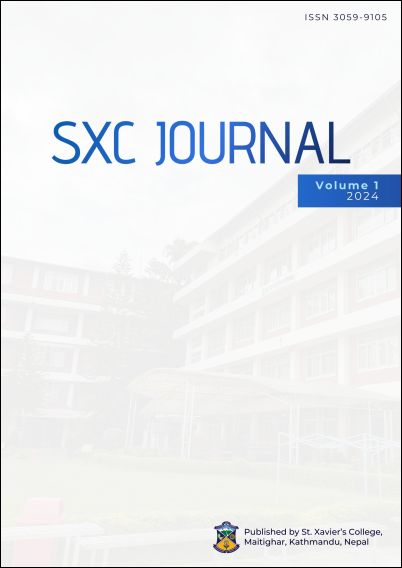Physicochemical and Antibacterial Properties of Nepalese Honey
DOI:
https://doi.org/10.3126/sxcj.v1i1.70876Keywords:
Physicochemical properties, antibacterial activity, S. aureus, P. aeruginosaAbstract
Nepal has a variety of honey and bee products that are dependent on floral sources available in a particular geographical region. The purpose of this study was to compare the physicochemical and antibacterial properties for the quality analysis of different honey samples. Honey samples were gathered from eight different districts of Nepal, which were assessed for their color, ash content, moisture, electrical conductivity, pH, acidity, formaldehyde content, protein concentration, reducing sugar, total reducing sugar, sucrose content, and antibacterial properties. The color and protein were determined using a colorimeter, ash content using a muffle furnace at 550°C, moisture using a refractometer, and electrical conductivity using a conductivity meter. Acidity, formaldehyde, reducing sugar, total reducing sugar, and sucrose content were determined by the titrimetric method while the antibacterial potential was determined by the agar well diffusion method. The results indicated that six honey samples were dark amber and others were light amber in color. The mean values were found ranging from 18.4+0 to 20.8+0.69% for moisture, 0.05+0.04 to 1.35+0.26% for ash, 0.03+0.01 to 1184+5.26 μs/cm for electrical conductivity, 4.5+0.06 to 7.47 +0.06 for pH, 90 to 137 meq/kg for acidity, 1 to 10 ml/kg for formaldehyde content, 0.28 to 0.73 mg/ml for protein concentration, 51.54% to 69.44% for reducing sugar, 65.35 to 80% for total reducing sugar, and 1.31 to 13.52% for sucrose. Out of the eight honey samples, four were able to show antimicrobial activity against Staphylococcus aureus ATCC 6538 while honey from Sindhupalchowk and Baitadi was also active against S. epidermidis ATCC 12228, and no other samples showed inhibitory activity against Escherichia coli ATCC 8739 and Listeria monocytogenes ATCC 19115. The honey sample from Lamjung was able to exhibit the highest antimicrobial activity against Pseudomonas aeruginosa ATCC 9027 at 1250 mg/ml concentration, while the lowest antimicrobial activity was shown by the sample from Chitwan at 750 mg/ml concentration against S. aureus, thus reflecting the significance of using honey as a natural remedy. This study indicated the essence of quantitative assessment of honey samples in terms of physicochemical parameters to ensure the quality of honey samples.
Downloads
Downloads
Published
How to Cite
Issue
Section
License
Copyright (c) 2024 The Author(s)

This work is licensed under a Creative Commons Attribution 4.0 International License.
This license enables reusers to distribute, remix, adapt, and build upon the material in any medium or format, so long as attribution is given to the creator. The license allows for commercial use.




